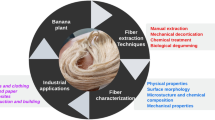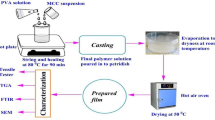Abstract
The culture substrate of Auricularia auricula contains lots of wood residues, which is not easy to compost or be used to produce feed. In this study, the spent culture substrate of Auricularia auricula (SSA) was used as raw material to prepare cellulose nanocrystals (CNCs). The CNCs were prepared by hydrolysis of the cellulose extracted from SSA (SSAC) with H2SO4 aqueous solution. The effect of concentration of H2SO4, acid hydrolysis temperature and hydrolysis time on the properties of CNCs and the reaction mechanism were studied. When the cellulose extracted from SSA (SSAC) was treated with 45 wt% H2SO4 at 45 °C for 120 min, the obtained CNCs was slender needle-like and the yield was 67.25 wt% (based on the mass of cellulose from pretreated SSA). The obtained CNCs in this condition have a crystallinity of 73.15% and the diameter distribute between 4 and 16 nm. The results show that the residual wood in SSA could prepare CNCs with higher crystallinity and smaller particle size under a more moderate condition. This study provides a new approach for the reuse of spent culture substrate of Auricularia auricula as well as a new cheap raw material for preparation of CNCs.
Graphical abstract









Similar content being viewed by others
References
Winter A, Arminger B, Veigel S, Gusenbauer C, Fischer W, Mayr M, Bauer W, Gindl-Altmutter W (2020) Nanocellulose from fractionated sulfite wood pulp. Cellulose 27:9325–9336. https://doi.org/10.1007/s10570-020-03428-8
Brito BSL, Pereira FV, Putaux JL, Jean B (2012) Preparation, morphology and structure of cellulose nanocrystals from bamboo fibers. Cellulose 19:1527–1536. https://doi.org/10.1007/s10570-012-9738-9
Rajala S, Siponkoski T, Sarlin E, Mettänen M, Vuoriluoto M, Pammo A, Juuti J, Rojas OJ, Franssila S, Tuukkanen S (2016) Cellulose nanofibril film as a piezoelectric sensor material. ACS Appl Mater Interfaces 8(24):15607–15614. https://doi.org/10.1021/acsami.6b03597
Klemm D, Cranston ED, Fischer D, Gama M, Kedzior SA, Kralisch D, Kramer F, Kondo T, Lindström T, Nietzsche S, Petzold-Welcke K, Rauchfu F (2018) Nanocellulose as a natural source for groundbreaking applications in materials science: today’s state. Mater Today 21(7):720–748. https://doi.org/10.1016/j.mattod.2018.02.001
Lu Q, Tang L, Wang S, Huang B, Chen Y, Chen X (2014) An investigation on the characteristics of cellulose nanocrystals from Pennisetum sinese. Biomass Bioenergy 70:267–272. https://doi.org/10.1016/j.biombioe.2014.09.012
Miao X, Lin J, Bian F (2020) Utilization of discarded crop straw to produce cellulose nanofibrils and their assemblies. J Bioresour Bioprod 5(1):26–36. https://doi.org/10.1016/j.jobab.2020.03.003
Hafemann E, Battisti R, Bresolin D, Marangoni C, Machado RAF (2020) Enhancing chlorine-free purification routes of rice husk biomass waste to obtain cellulose nanocrystals. Waste Biomass Valori 11(12):6595–6611. https://doi.org/10.1007/s12649-020-00937-2
Saito T, Isogai A (2004) TEMPO-mediated oxidation of native cellulose: the effect of oxidation conditions on chemical and crystal structures of the water-insoluble fractions. Biomacromol 5(5):1983–1989. https://doi.org/10.1021/bm0497769
Abushammala H, Krossing I, Laborie MP (2015) Ionic liquid-mediated technology to produce cellulose nanocrystals directly from wood. Carbohydr Polym 134(10):609–616. https://doi.org/10.1016/j.carbpol.2015.07.079
Kiper AG, Özyuguran A, Yaman S (2020) Electrospun cellulose nanofibers from toilet paper. J Mater Cycles Waste Manag 22:1999–2011. https://doi.org/10.1007/s10163-020-01085-4
Oksman K, Etang JA, Mathew AP, Jonoobi M (2011) Cellulose nanowhiskers separated from a bio-residue from wood bioethanol production. Biomass Bioenergy 35(1):146–152. https://doi.org/10.1016/j.biombioe.2010.08.021
Klemm D, Kramer F, Moritz S, Lindström T, Ankerfors M, Gray D, Dorris A (2011) Nanocelluloses: a new family of nature-based materials. Angew Chem Int Ed Engl 50(24):5438–5466. https://doi.org/10.1002/anie.201001273
Abdul Rahman NH, Chieng BW, Ibrahim NA, Abdul Rahman N (2017) Extraction and characterization of cellulose nanocrystals from tea-leaf waste fibers. Polymers 9(11):588. https://doi.org/10.3390/polym9110588
Zhang P, Tong D, Lin C, Yang H, Zhong Z, Yu W, Wang H, Zhou C (2014) Effects of acid treatments on bamboo cellulose nanocrystals. Asia Pac J Chem Eng 9(5):686–695. https://doi.org/10.1002/apj.1812
Beck-Candanedo S, Roman M, Gray DG (2005) Effect of reaction conditions on the properties and behavior of wood cellulose nanocrystal suspensions. Biomacromol 6(2):1048–1054. https://doi.org/10.1021/bm049300p
Bondeson D, Mathew A, Oksman K (2006) Optimization of the isolation of nanocrystals from microcrystalline cellulose by acid hydrolysis. Cellulose 13(2):171–180. https://doi.org/10.1007/s10570-006-9061-4
Moon RJ, Martini A, Nairn J, Simonsen J, Youngblood J (2011) Cellulose nanomaterials review: structure, properties and nanocomposites. Chem Soc Rev 40(7):3941–3994. https://doi.org/10.1039/C0CS00108B
Vikman M, Vartiainen J, Tsitko I, Korhonen P (2015) Biodegradability and compost ability of nanofibrillar cellulose-based products. J Polym Environ 23:206–215. https://doi.org/10.1007/s10924-014-0694-3
Wang Y, Wei X, Li J, Wang F, Wang Q, Zhang Y, Kong L (2017) Homogeneous isolation of nanocellulose from eucalyptus pulp by high pressure homogenization. Ind Crop Prod 104:237–241. https://doi.org/10.1016/j.indcrop.2017.04.032
Diop CIK, Lavoie JM (2017) Isolation of nanocrystalline cellulose: a technological route for valorizing recycled tetra pak aseptic multilayered food packaging wastes. Waste Biomass Valori 8(1):41–56. https://doi.org/10.1007/s12649-016-9585-2
Tan XY, Abd Hamid SB, Lai CW (2015) Preparation of high crystallinity cellulose nanocrystals (CNCs) by ionic liquid solvolysis. Biomass Bioenergy 81:584–591. https://doi.org/10.1016/j.biombioe.2015.08.016
Azam M, Jahromy SS, Raza W, Raza N, Lee SS, Kim KH, Winter F (2020) Status, characterization, and potential utilization of municipal solid waste as renewable energy source: Lahore case study in Pakistan. Environ Int 134:105291. https://doi.org/10.1016/j.envint.2019.105291
Mohd Hanafi FH, Rezania S, Mat Taib S, Md Din MF, Yamauchi M, Sakamoto M, Hara H, Park J, Ebrahimi SS (2018) Environmentally sustainable applications of agro-based spent mushroom substrate (SMS): an overview. J Mater Cycles Waste Manag 20:1383–1396. https://doi.org/10.1007/s10163-018-0739-0
Van Soest PJ, Wine RH (1967) Use of detergents in the analysis of fibrous feeds, IV. Determination of plant cell-wall constituents. J Assoc Off Anal Chem 50:50–55. https://doi.org/10.1093/jaoac/50.1.50
Segal L, Creely JJ, Martin AE, Conrad CM (1959) An empirical method for estimating the degree of crystallinity of native cellulose using the X-ray diffractometer. Text Res J 29(10):786–794. https://doi.org/10.1177/004051755902901003
Park S, Baker J, Himmel M, Parilla P, Johnson D (2010) Cellulose crystallinity index: measurement techniques and their impact on interpreting cellulase performance. Biotechnol Biofuels 3:10. https://doi.org/10.1186/1754-6834-3-10
Jiang F, Hsieh YL (2013) Chemically and mechanically isolated nanocellulose and their self-assembled structures. Carbohydr Polym 95(1):32–40. https://doi.org/10.1016/j.carbpol.2013.02.022
Wang J, Wang Q, Wu Y, Bai F, Wang H, Si S, Lu Y, Li X, Wang S (2020) Preparation of cellulose nanofibers from bagasse by phosphoric acid and hydrogen peroxide enables fibrillation via a swelling, hydrolysis, and oxidation cooperative mechanism. Nanomaterials 10(11):2227. https://doi.org/10.3390/nano10112227
Lu P, Hsieh YL (2012) Preparation and characterization of cellulose nanocrystals from rice straw. Carbohydr Polym 87(1):564–573. https://doi.org/10.1016/j.carbpol.2011.08.022
Langkilde FW, Svantesson A (1995) Identification of celluloses with Fourier-Transform (FT) mid-infrared, FT-Raman and near-infrared spectrometry. J Pharm Biomed 13(4–5):409–414. https://doi.org/10.1016/0731-7085(95)01298-Y
Baranov A, Sommerhoff F, Duchemin B, Curnow O, Staiger MP (2021) Toward a facile fabrication route for all-cellulose composite laminates via partial dissolution in aqueous tetrabutylphosphonium hydroxide solution. Compos Part A Appl Sci Manuf 140:106148. https://doi.org/10.1016/j.compositesa.2020.106148
Yang H, Yan R, Chen H, Lee DH, Zheng C (2007) Characteristics of hemicellulose, cellulose and lignin pyrolysis. Fuel 86(12–13):1781–1788. https://doi.org/10.1016/j.fuel.2006.12.013
Tonoli GHD, Teixeira EM, Corrêa AC, Marconcini JM, Caixeta LA, Pereira-da-Silva MA, Mattoso LHC (2012) Cellulose micro/nanofibres from Eucalyptus kraft pulp: preparation and properties. Carbohydr Polym 89(1):80–88. https://doi.org/10.1016/j.carbpol.2012.02.052
Chen X, Yu J, Zhang Z, Lu C (2011) Study on structure and thermal stability properties of cellulose fibers from rice straw. Carbohydr Polym 85(1):245–250. https://doi.org/10.1016/j.carbpol.2011.02.022
Wang Z, Yao Z, Zhou J, Zhang Y (2017) Reuse of waste cotton cloth for the extraction of cellulose nanocrystals. Carbohydr Polym 157:945–952. https://doi.org/10.1016/j.carbpol.2016.10.044
Acknowledgements
This work was supported by the National Key Research and Development Program of China (No. 2021YFD1600402), the Xi'an Science and Technology Plan (No. 22GXFW0071) and National Natural Science Foundation of China (No. 52000151).
Author information
Authors and Affiliations
Corresponding author
Additional information
Publisher's Note
Springer Nature remains neutral with regard to jurisdictional claims in published maps and institutional affiliations.
Rights and permissions
Springer Nature or its licensor (e.g. a society or other partner) holds exclusive rights to this article under a publishing agreement with the author(s) or other rightsholder(s); author self-archiving of the accepted manuscript version of this article is solely governed by the terms of such publishing agreement and applicable law.
About this article
Cite this article
Su, J., Zhang, X., Yang, M. et al. Preparation and characterization of cellulose nanocrystals from spent culture substrate of Auricularia auricula. J Mater Cycles Waste Manag 25, 2915–2924 (2023). https://doi.org/10.1007/s10163-023-01724-6
Received:
Accepted:
Published:
Issue Date:
DOI: https://doi.org/10.1007/s10163-023-01724-6




